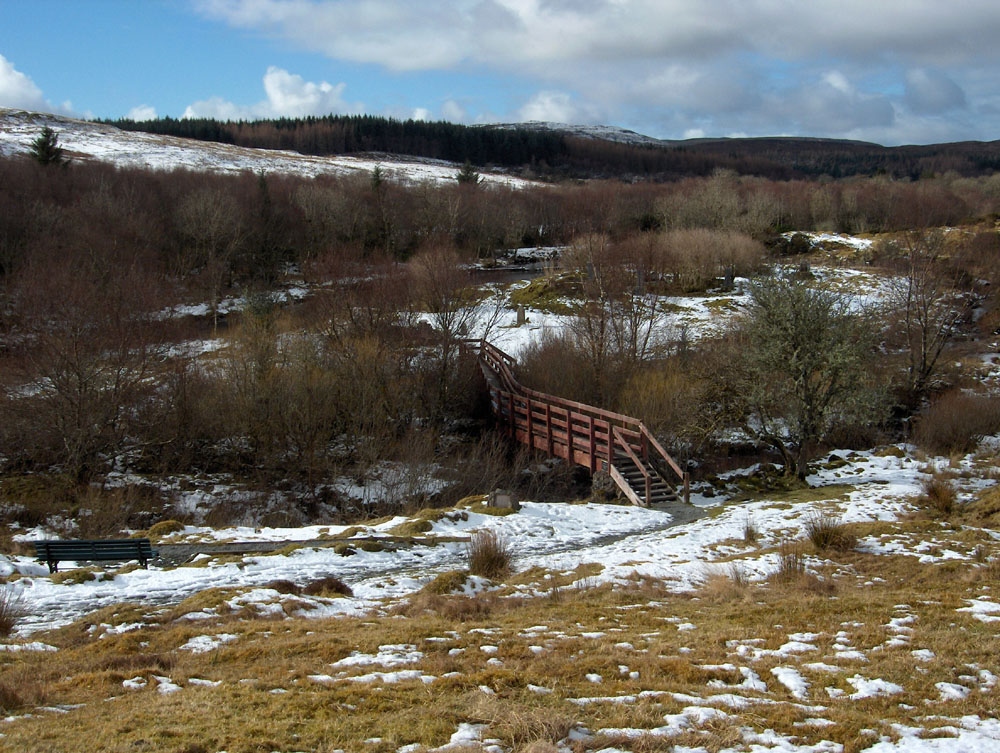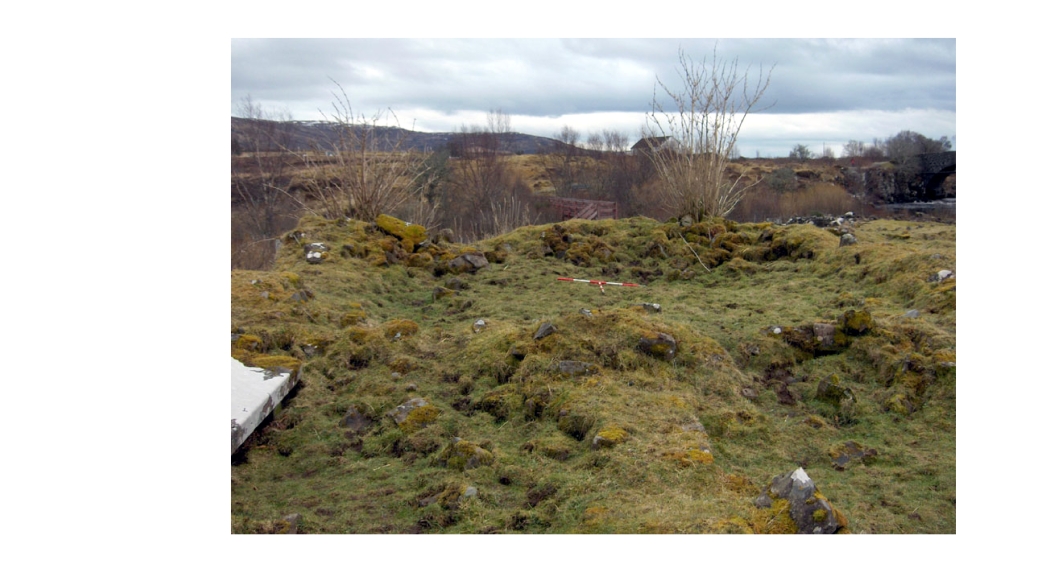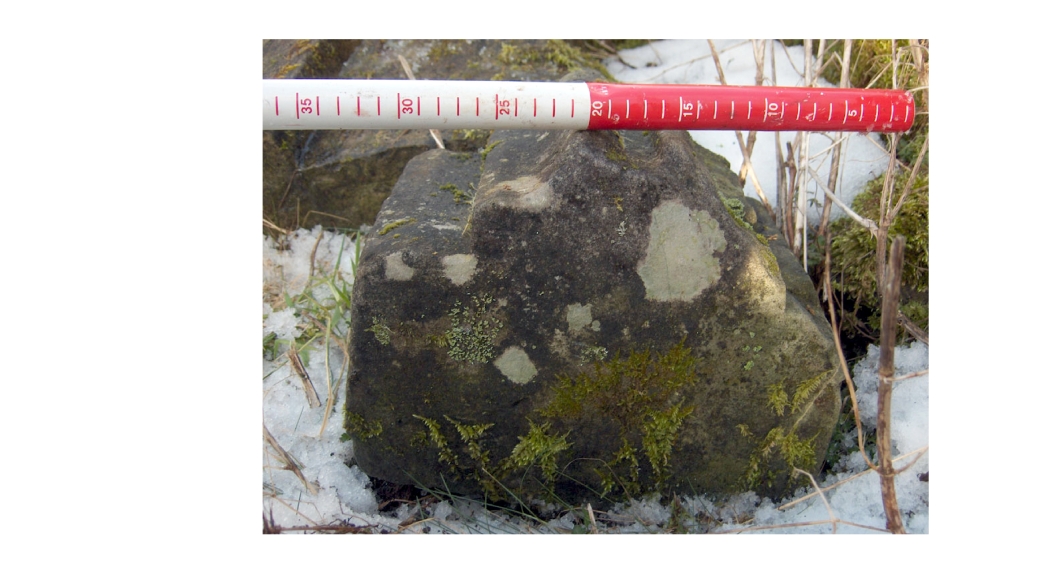As the diocese of Sodor split in two, unable to maintain its unity with the pressures of the Great Schism and the secular geopolitical English and Scottish struggle for control over the Isle of Man, the new Scottish diocese found itself in need of a new cathedral seat, having lost access to the old cathedral which was located on the Isle of Man. Their choice was the island of Snizort in northern Skye; on this very small island, measuring no more than 50m north-south and 100m east-west and lying in the river Snizort about 420m from its outfall into Loch Snizort, there was almost certainly already a church dedicated to St Columba.

Skeabost Island, Snizort, Skye (S.E. Thomas)

View of the eastern end of the church at Snizort (S.E.Thomas)
The site has historically been much neglected, though in the last twenty years increasing interest has resulted in the building of a footbridge across to the island, the collection of sculptural fragments and finally a topographical survey by the author, Dr Sarah Thomas. The most interesting feature is the church which dominates the island, even in its ruined state, occupying as it does the central and highest space. It measures 23m by 5.3m with a total internal area of 121.9m². By Hebridean standards, this was a large, substantial church; it was certainly one of the longest. Its area is increased by two additional structures, one on its south side which measures c.5m x 10.6m and the other a platform area to the north of the church. In my recent article for the Proceedings of the Society of Antiquaries of Scotland, I have interpreted these two features as a lateral chapel and possible range buildings. So little survives of the structure that it is hard to date it; however, two architectural fragments provide some assistance and indeed suggest at least two phases of building. The first fragment is a fluted or reeded nook-shaft capital whose closest parallels are two early 13th-century column capitals from the monastery of Iona. These parallels suggest that the masons working at Snizort had also plied their trade at Iona. A piece of roll moulding, probably of either 14th or 15th century date, provides evidence of rebuilding or expansion in the later Middle Ages. To the east of the large church there is a smaller building, measuring 5.65m x 3.95m with an internal area of 22.3m². This chapel is known as the Nicolson aisle because there is a tradition that the chiefs of this family were buried there. It probably dates to the later Middle Ages; possibly to after the main church had been abandoned.

Late medieval roll moulding, Snizort (S.E.Thomas)
The large church was almost certainly the cathedral used by the late-fourteenth and fifteenth-century bishops. There were six bishops of the Scottish diocese of Sodor between 1387 and 1500. Three were native Hebrideans, one from neighbouring Argyll and two from Ireland. One, Bishop Michael, was the first only Franciscan friar to serve as bishop of Sodor, whilst all but one were secular clergy. Two, John son of Hector MacLean and John Campbell, were archdeacons before their promotion, respectively of Sodor and Argyll. Only Bishops Michael had a degree, for all the others there are no references to them having attended university, let alone achieving a degree. The best connected of the six was Bishop Angus (1426-1441); he was the illegitimate son of Donald, Lord of the Isles. Admittedly, his successor but one was almost nearly as well connected since he was Bishop Angus’s son! The first Bishop Angus is the only bishop whom we can connect with confidence to Snizort. In a papal petition of 1433, he requested permission to move his cathedral from Snizort to ‘some honest place within the diocese’.[1] What he meant by some honest place we cannot be sure, but it may reflect MacDonald discomfiture with a cathedral seat outside their heartland of Kintyre and Islay. The criticism of a lack of honesty may therefore reflect political considerations, rather than poor religious practices.
Our project is examining these bishops along with their predecessors and comparing them with the bishops in mainland Scotland, England and Scandinavia. Through this comparison, we hope to determine whether they had similar or different backgrounds and careers from their contemporaries elsewhere in northern Europe. Were the bishops of this distant northern diocese typical or atypical of Christendom?
Bibliography
Oram, R.D., ‘The Lordship of the Isles: 1336-1545’, in ed. Omand, D., The Argyll Book (Edinburgh: Birlinn 2004) 123-139.
Thomas, S.E., ‘From cathedral of the Isles to obscurity – the Archaeology and History of Skeabost Island’, Proceedings of the Society of Antiquaries of Scotland 144 (2015) 245-264.
Thomas, S.E., ‘Rival bishops, rival cathedrals: the election of Cormac, archdeacon of Sodor, as bishop in 1331’, The Innes Review 60:2 (2009) 145-163.
Woolf, A., ‘The diocese of the Sudreyar’, in ed. Imsen, S., Ecclesia Nidrosiensis 1153-1537: Sokelys på Nidaroskirkens og Nidarosprovinsens historie (Trondheim: Tapir 2003) 171-182.
[1] Calendar of Scottish Supplications to Rome Volume IV 1433-1447, ed. A.I. Dunlop and D. MacLauchlan (Glasgow: University of Glasgow Press 1983)25.